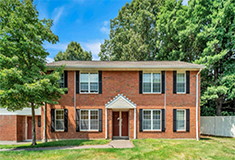News:
Connecticut
Posted: March 20, 2014
Life estates and an approach to valuation
Inherent in the fee simple ownership of real estate is something that is commonly referred to as the "Bundle of Rights." The Bundle of Rights is in effect the exclusive right, use and disposition of the property that belong to the property owner. The owner of the Bundle of Rights typically has the ability to convey all or some of those rights to another. The conveyance of the right to another person that enables them to occupy a property for the duration of their life is commonly known as a life estate. The beneficiary of the life estate is referred to as the tenant. The person or entity that actually has the ownership in the real property is referred to as the remainderman.
The life estate interest is an estate in real property that ends upon the death of the holder of life estate, (the tenant). The property may then revert back to the original owner of the property or some other designated person (the remainderman).
Uses of a Life Estate
The life estate is typically used as a tool for estate planning. A life estate can avoid probate and insure that the intended heir will receive title to the real property.
The Appraiser's Role
There are multiple scenarios where an appraiser is needed to evaluate a life estate. Sometimes the role of the appraiser is to estimate the value of the interest for the tenant and sometimes the role is to estimate the value of the remainderman.
Valuation Scenario -
Remainderman's Interest
The following is an example where the appraiser's role is to value the interest of the remainderman. The property is encumbered by a life use that has been granted to a 70-year-old person.
There are a series of steps that must be taken in this valuation scenario which are summarized as follows:
* Estimate the fee simple market value of the property assuming it is unencumbered as of the date of conveyance. The scenario presented assumes a fee simple market value of $500,000.
* Estimate the term of the life estate. This element is based upon the age of the beneficiary (the tenant) of the life estate and their life expectancy. Life expectancy can be estimated from a variety of published tables including that of the tables included in IRS publication 590, which contains a table of life expectancies based upon age. In the case of this valuation scenario, the beneficiary is 70 years old and has a life expectancy of 17 years. The following is an excerpt from the Life-Expectancy table that is included in IRS publication 590:
* Estimate the expected rate of appreciation over the life expectancy. There are a variety of statistical references that an appraiser can utilize to estimate the expected rate of appreciation. For this valuation scenario let's assume that the property will achieve a rate of appreciation that is typical of the general market.
In this case your appraiser might utilize an institutional or nationally recognized benchmark such as the Consumer Price Index (all items). The benchmark chosen in this case was the twenty-year average of the Consumer Price Index (CPI), "all items." The twenty-year average mirrors the term of the life expectancy of the tenant with CPI being one of most reliable and least subjective measurements of anticipated appreciation. A review of the CPI index, as published by the Bureau of Labor Statistics between 1993 and 2013 revealed an average rate of inflation of 3.1%. Inflation over the past ten years has averaged less than 3%. Your appraiser has chosen a rate of 3% for the anticipated annual rate of appreciation.
* Discount the forecasted future value of the property over the remaining duration of the life estate at an appropriate discount rate. Discount rate is synonymous with what would be an expected rate of return for a like property.
Expected rate of return/discount rate is essentially synonymous with the rate that an investor would expect over the anticipated holding period. Your appraiser in this case has consulted the Price Waterhouse Coopers Investor Survey that was published for the second quarter of 2013. Discount rates for residential apartment properties ranged from 5% to 14% with an average of 8.04%. The subject property being a residential single family home would generally result in a rate at the lower end of the scale simply because it is not exclusively viewed as an investment vehicle. Your appraiser has estimated a rate of 7% for the subject property.
Other benchmarks for expected rate of return could be long-term treasuries, bonds, equities or some type of index fund as these investment vehicles could all be alternatives to investing in real estate
The remainderman's interest is valued at $262,000, much lower than the fee simple market value of $500,000.
Marc Nadeau is a designated appraiser with Nadeau & Associates, Guilford, Connecticut.
Tags:
Connecticut
MORE FROM Connecticut
CBRE brokers sale of Stamford Towers - 326,468 s/f Class A office
Stamford, CT The CBRE team of Jeff Dunne, Steve Bardsley, and Travis Langer, in collaboration with David Block, completed the sale of Stamford Towers, located at 680 & 750 Washington Blvd. CBRE represented the seller, CBRE Investment Management, and procured the buyer, a joint venture of Lamar Companies

Quick Hits










.png)